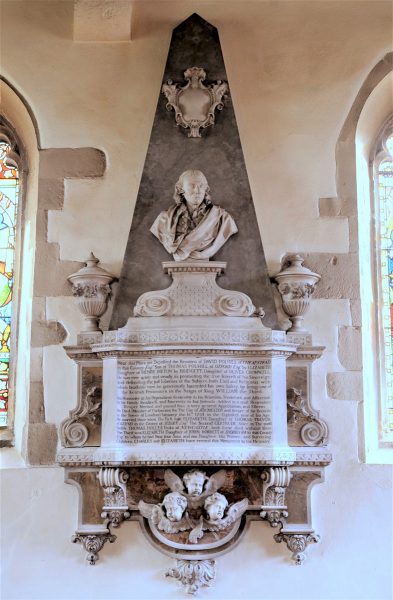Our distinguished member, Professor Stephen Bann, gave a most interesting lecture on this subject at Lenham on 17 October, attended by about 45 members. Formerly Professor of the History of Art at Bristol University, Stephen gave the Slade lectures at Cambridge in 2017 on evidence about participants in the English Civil War from church monuments and other sources. Those lectures, subsequently published in book form, covered England as a whole; in our lecture Stephen talked mainly about east Kent, where sympathy for the Crown was strong, unlike the west of the county which was mostly for Parliament.
Stephen introduced us to several east Kent families active in the Civil War, notably the Bargraves of Patrixbourne, who had built a fine house called Bifrons there early in the 17th century. The house is known only from a splendid bird’s-eye view painted by Jan Siberechts, now at the Yale Centre for British Art at New Haven. Robert Bargrave, who died in 1649, is commemorated by a very unusual painted portrait, perhaps by Cornelius Johnson, at St Peter’s, Bridge.
We were also shown the work of the Kentish sculptor Epiphanius Evesham, whom Stephen thought might have been responsible for the monument in Bath Abbey to the wife of the royalist general Sir William Waller on account of its similarity to Evesham’s earlier monument at Otterden to Sir Justinian Lewin.
The monument to David Polhill at Otford, with its magnificent bust by Sir Henry Cheere (see photograph below), provides a much later allusion to the Civil War and Commonwealth, in that Polhill descended from Oliver Cromwell through his daughter, Bridget, who married the Parliamentary general Henry Ireton. Since both Cromwell and Ireton were still figures of ill-repute – if not hate – in the 1750s, it is remarkable that the inscription on the monument so readily proclaims Polhill’s descent from them.
This was a lecture on a subject quite unlike any other given to the Friends and was all the more welcome for that.


